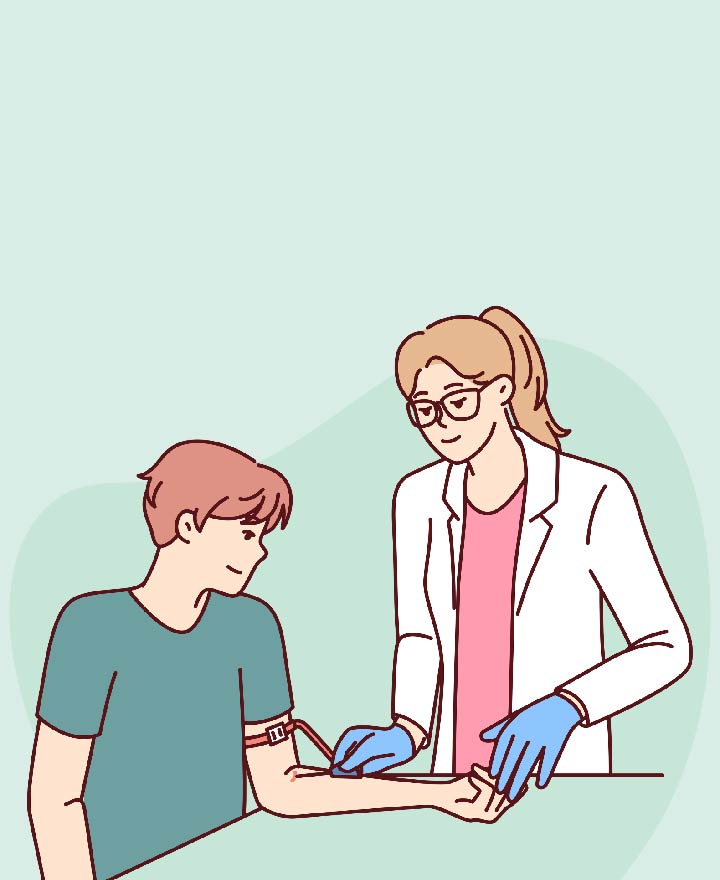

Sickle Cell Anaemia: Symptoms, Causes and Treatment
Sickle cell anaemia is a herediatry hemoglobinopathy that affects the shape and function of red blood cells. It’s one form of sickle cell disease (SCD) and is most common among people of African, Mediterranean, Middle Eastern, and Indian descent. Though it is a lifelong condition, early diagnosis and proper treatment can greatly improve outcomes and help individuals lead a better quality of life. Read on to learn more about this condition in detail.
What is Sickle Cell Anaemia?
Sickle cell anaemia is a genetic blood disorder that affects the red blood cells, causing them to become abnormally shaped and function poorly. Sickle cell anaemia develops due to a mutation in the gene responsible for making haemoglobin, the protein that facilitates red blood cells to carry oxygen. In this condition, the red blood cells become shaped like a sickle or crescent moon. These cells are- stiff and sticky, and they clump together, blocking blood flow. These cells break down early, leading to anemia (a shortage of red blood cells).
Symptoms
Sickle cell disease symptoms usually begin around six months of age and may vary over time. Common symptoms include:
• Fatigue (anaemia):
A shortage of red blood cells leads to low oxygen levels, causing tiredness and weakness.
• Pain crises:
Sudden episodes of sharp or throbbing pain, often in the chest, back, joints, arms or legs, due to blocked blood flow.
• Frequent infections:
Damage to the spleen weakens the immune system, increasing the risk of infections.
• Jaundice:
Yellowing of the skin and eyes from the rapid breakdown of red blood cells.
• Delayed growth and puberty:
A lack of oxygen and nutrients slows physical development.
Causes
Sickle cell anaemia causes are hereditary. For a child to have sickle cell anaemia, they must inherit one sickle cell gene from each biological parent.
• If a person inherits only one copy, they have sickle cell trait. They usually do not have symptoms or may have very mild ones. However, they can pass the gene on to their children.
• If both parents carry the gene, there's a 25% chance with each pregnancy that the offspring will inherit sickle cell anaemia.
Health Risks and Complications
Here are the risks and complications involved:
• Organ damage:
Ongoing blockages in blood vessels reduce oxygen supply to vital organs like the liver, kidneys, heart and spleen. Over time, this can contribute to permanent damage or even organ failure.
• Stroke:
Children and adults with sickle cell anaemia are at risk of stroke, as sickled cells can interrupt blood flow to the brain. Warning signs include sudden weakness, slurred speech, seizures or fainting. It's a medical emergency that needs urgent care.
• Acute chest syndrome:
This is a severe and potentially fatal condition involving blocked blood vessels or infection in the lungs. It causes chest pain, fever, coughing and difficulty breathing and often needs hospital care.
• Avascular necrosis:
When bones, especially in the hips or shoulders, don’t get enough blood, they can weaken or break down. This leads to joint pain, stiffness and limited movement.
• Priapism:
In males, blocked blood flow in the penis can cause painful, prolonged erections. If not treated in time, it can lead to lasting damage or erectile dysfunction.
• Splenic sequestration:
Sickle cells can get stuck in the spleen, causing it to swell and reduce blood volume dangerously. This can lead to severe anaemia and requires urgent attention.
Diagnosis
Sickle cell anaemia is most often diagnosed early in life through routine newborn screening. A blood sample is tested to detect abnormal haemoglobin (HbS). If the test is positive, further testing is done to confirm the diagnosis.
Key diagnostic tests include:
• Haemoglobin electrophoresis or high-performance liquid chromatography (HPLC):
These tests identify the type of haemoglobin in the blood.
• Complete blood count (CBC):
Helps detect anaemia and other blood cell abnormalities.
• Genetic testing:
Identifies the presence of sickle cell mutations and can also determine if someone is a carrier (sickle cell trait).
Treatment
While sickle cell anaemia cannot be completely cured in most cases, a range of treatments is available to manage symptoms, lower the risk of complications and support better daily functioning. These may include:
A) Medications
• Hydroxyurea:
Taken daily to reduce pain episodes and might reduce the need for blood transfusions and hospital visits. Not recommended during pregnancy.
• L-glutamine:
Helps lower the frequency of pain episodes.
• Crizanlizumab:
An injectable medicine for patients over 16, used to reduce pain episodes.
• Voxelotor:
Improves haemoglobin levels and blood flow in patients over 12; may cause mild side effects like nausea and headache.
B) Other Treatments
• Blood transfusions:
Supply healthy red blood cells to improve oxygen levels, treat severe anaemia and prevent complications like stroke.
• Stem cell transplant:
A potential cure involving the replacement of the patient’s bone marrow with healthy stem cells from a matched donor, generally a sibling.
• Stem cell gene addition therapy:
A developing treatment where healthy copies of a gene are added to the patient’s stem cells to produce normal haemoglobin and reduce sickling.
Preventive Measures and Risk Management
Along with medical treatment, simple lifestyle choices can make a big difference in reducing complications:
• Include fruits, vegetables and whole grains and ask your doctor about folic acid supplements.
• Drink plenty of water, especially in heat or during physical activity.
• Avoid temperature extremes, as sudden exposure to heat or cold can trigger pain.
• Check with the doctor before taking over-the-counter pain relievers.
• Smoking can worsen symptoms and raise your risk of crises.
Conclusion
Sickle cell anaemia disease requires lifelong care, from regular doctor visits and lab tests to medicines and sometimes hospital stays. These costs can add up over time, making it important to plan ahead. Having health insurance gives you access to timely treatment without worrying about the financial burden. You can easily get health insurance online to cover your medical needs.
One of the important components of our overall wellness is also being financially secured. Healthcare emergencies can happen any time, but a good health insurance policy can protect you from such uncertain situations. To know more about Wellness and other health related tips, visit the wellness corner.
Sources: cdc.gov, mayoclinic.org, clevelandclinic.org, hopkinsmedicine.org, academic.oup.com
Disclaimer: This blog provides general information and discussions about health and related subjects. The information and other content provided in this blog, website or any linked materials are not intended and should not be considered or used as a substitute for medical advice, diagnosis or treatment. Kindly contact your doctor before starting a new medicine or health regime.
Related Articles
Is Jaundice a Transmittable Disease?
Published on July 8, 2025















 Health Insurance
Health Insurance  Travel Insurance
Travel Insurance  Car Insurance
Car Insurance  Cyber Insurance
Cyber Insurance  Critical Illness Insurance
Critical Illness Insurance
 Pet Insurance
Pet Insurance
 Bike/Two Wheeler Insurance
Bike/Two Wheeler Insurance  Home Insurance
Home Insurance  Third Party Vehicle Ins.
Third Party Vehicle Ins.  Tractor Insurance
Tractor Insurance  Goods Carrying Vehicle Ins.
Goods Carrying Vehicle Ins.  Passenger Carrying Vehicle Ins.
Passenger Carrying Vehicle Ins.  Compulsory Personal Accident Insurance
Compulsory Personal Accident Insurance  Travel Insurance
Travel Insurance  Rural
Rural